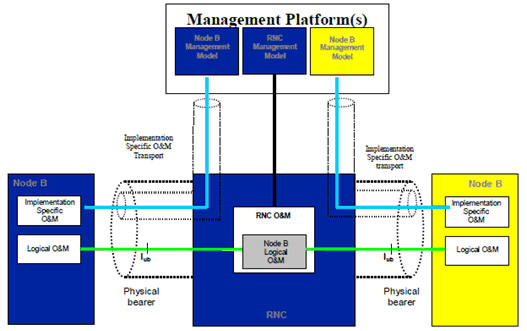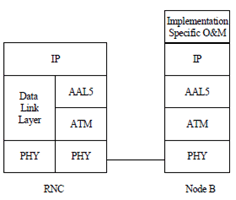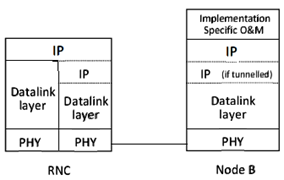TS 25.442
UTRAN – implementation-specific OAM Transport
V18.0.0 (PDF)
2024/03 … p.
V17.0.0
2022/03 11 p.
V16.0.0
2020/06 11 p.
V15.0.0
2018/06 11 p.
V14.0.0
2017/03 11 p.
V13.0.0
2015/12 11 p.
V12.0.0
2014/09 11 p.
V11.0.0
2012/09 11 p.
V10.1.0
2011/06 11 p.
V9.0.1
2011/04 11 p.
V8.0.0
2009/01 11 p.
V7.0.0
2006/03 11 p.
V6.0.0
2004/01 11 p.
V5.1.0
2002/10 11 p.
V4.0.0
2001/04 10 p.
V3.1.0
2000/03 10 p.
- Rapporteur:
- Mr. Hauser, Alexander
Content for TS 25.442 Word version: 17.0.0
1 Scope p. 5
The present document specifies the transport of implementation specific O&M signalling between Node B and the Management Platform in case that the transport is routed via the RNC.
2 References p. 5
The following documents contain provisions which, through reference in this text, constitute provisions of the present document.
- References are either specific (identified by date of publication, edition number, version number, etc.) or non-specific.
- For a specific reference, subsequent revisions do not apply.
- For a non-specific reference, the latest version applies. In the case of a reference to a 3GPP document (including a GSM document), a non-specific reference implicitly refers to the latest version of that document in the same Release as the present document.
[1] Void
[2] Void
[3]
ITU-T Recommendation I.363.5 (1996-08): "B-ISDN ATM Adaptation Layer Type 5 Specification".
[4]
RFC 2225 (1998-04): "Classical IP and ARP over ATM".
[5]
RFC 2684 (1999-09): "Multiprotocol Encapsulation over ATM Adaptation Layer 5".
[6]
RFC 791 (1981-09): "Internet Protocol".
[7] Void
[8]
TS 25.426: "UTRAN Iur and Iub Interface Data Transport&Transport Signalling for DCH".
3 Definitions and abbreviations p. 5
3.1 Definitions p. 5
For the purposes of the present document, the following terms and definitions apply:
Logical O&M:
Logical O&M is the signalling associated with the control of logical resources owned by the RNC but physically implemented in Node B.
Implementation Specific O&M:
Implementation Specific O&M functions depend on the implementation of the Node B, both for its hardware and software components.
3.2 Abbreviations p. 5
For the purposes of the present document, the following abbreviations apply:
AAL5
ATM Adaptation Layer type 5
ATM
Asynchronous Transfer Mode
ARP
Address Resolution Protocol
RFC
Request For Comment
IP
Internet Protocol
O&M
Operation and Maintenance
RNC
Radio Network Controller
TNL
Transport Network Layer
4 Implementation Specific O&M Transport p. 6
4.1 Requirements p. 6
While this specification only addresses the transport of Node B Implementation Specific O&M signalling, many of the following requirements are derived from generic requirements for O&M of UMTS network elements:
- Common O&M infrastructure for all network elements.
- Independence from various data link protocols.
- Support of various higher layer protocols and applications.
- Secure transmission.
- No Impact of O&M transport on traffic transport and signalling.
- Re-use of existing transport facilities, i.e. co-existence of Iub and Implementation Specific O&M on the same bearer.
4.2 Routing p. 6
It is the responsibility of the RNC to route Implementation Specific O&M signalling traffic. The traffic exchanged over this signalling link is completely transparent to the RNC. Both RNC and Node B have to support the routing of Implementation specific O&M via the RNC.

4.3 Transport Bearer p. 7
An appropriate transport bearer for Implementation Specific O&M should consider the requirements listed in subclause 4.1. IP (IETF RFC 791 [6]) should be the transport mechanism in order to allow a data link independent support of a variety of O&M applications and protocols for the Implementation Specific O&M of the Node B.
IP datagrams containing O&M signalling have to be carried over the same bearer as Iub. There are two options for the implementation specific O&M signalling bearer in Iub.
- ATM Transport option
- IP Transport option
4.3.1 ATM Transport Option |R5| p. 7
The following figure shows the protocol stack for Implementation Specific O&M transport between Node B and RNC in case of ATM transport option in Iub:

Figure 2: Protocol Stack for Implementation Specific O&M Transport (ATM transport option)
(⇒ copy of original 3GPP image)
(⇒ copy of original 3GPP image)
AAL5 shall be used according to ITU-T Recommendation I.363.5 [3].
AAL5 virtual circuits are used to transport the IP packets containing Implementation Specific O&M signalling data between Node B and RNC. Multiple VCs can be used over the interface. An association shall be made between a VC and the IP addresses that are related to this VC in the peer node side. This association can be made using O&M or using ATM Inverse ARP according to Classical IP over ATM.
Classical IP over ATM protocols are used to carry the IP packets over the ATM transport network. Classical IP over ATM is specified in IETF RFC 2225 [4]. Multiprotocol Encapsulation over AAL5 is specified in IETF RFC 2684 [5].
4.3.2 IP Transport Option |R5| p. 7
The following figure shows the protocol stack for Implementation Specific O&M transport between Node B and RNC in case of IP transport option in Iub:

Figure 3: Protocol Stack for Implementation Specific O&M Transport (IP TNL)
(⇒ copy of original 3GPP image)
(⇒ copy of original 3GPP image)
Implementation specific O&M signalling is conveyed by IP between the Node B and the RNC. IP-in-IP tunneling may be applied when the Iub Transport Network Layer is used.
IP based Transport Network Layer of Iub is further defined in TS 25.426.